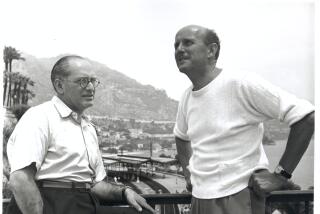‘COLONEL BLIMP’ AT COUNTY MUSEUM
- Share via
“The Life and Death of Colonel Blimp” (1943), which screens at 8 p.m. Saturday in the Michael Powell series at the County Museum of Art, offers the old-fashioned satisfaction of fully rounded central characters who evolve over an adult lifetime.
Written, produced and directed with Powell’s usual collaborator Emeric Pressburger, it spans 1902 to 1943 in the life of a kindly, aristocratic career officer (a superb Roger Livesey), a symbol of British fair play, who finds himself obsolete with the outbreak of World War II. This handsome Technicolor production, restored by the British Film Institute to its original 163 minutes, is subtle and paradoxical: Its makers regret their hero’s naivete while respecting his innate decency, and they anticipate the ruthlessness of the postwar world. Anton Walbrook is Livesey’s urbane German friend and rival; Deborah Kerr plays all the key women in both their lives.
“Colonel Blimp” will be followed by “The Spy in Black” (1939), another Powell-Pressburger thriller in the Hitchcockian style with Conrad Veidt and Valerie Hobson. Friday’s program, at 1 and again at 8 p.m., pairs one of Powell’s numerous war movies, “49th Parallel” (1941), and “The Lion Has Wings” (1939), a stiff-upper-lip war preparedness piece saluting the Royal Air Force and incorporating newsreels, documentary footage and dramatized sequences featuring Ralph Richardson, Merle Oberon, Flora Robson and even Ian Fleming, later to create James Bond. Powell co-directed with Brian Desmond Hurst and Adrian Brunel. Information: (213) 857-6201.
Nino Manfredi turned director with stunning success in his “Between Miracles” (1971), which screens Sunday at UCLA Melnitz at 9:30 p.m. as part of the “Comedy, Italian Style” series. This is a sprawling, sensual, bleakly ironic fresco of a movie that rings deeply true to the Italian spirit. “Between Miracles” evokes the eternal Catholic struggle between the spirit and the flesh as we witness, via flashback, Manfredi’s wistful 40-year-old virgin growing up a peasant in a primitive, ruggedly beautiful mountain village. Liberation comes at last--or does it?--to Manfredi when he meets a small-town pharmacist (Lionel Stander, in a triumphantly sly performance even though dubbed), a self-described “atheist saint” with a beautiful young daughter (Delia Boccardo). Alberto Sordi’s “Help Me, My Love” (1969) screens at 7:30 p.m. Information: (213) 825-2581.
Otto Preminger disavowed the five features he directed before “Laura” (1944), but his rarely seen first American film “Under Your Spell” (1936) turns up Thursday at 5:30 p.m. at UCLA Melnitz in the current Preminger series. Typical of the ‘30s attempts to turn opera singers into movie stars, it is the sixth and final film of Lawrence Tibbett, whose majestic voice is at odds with his very ordinary appearance. Except for a brief moment as Mephistopheles in Gounod’s “Faust,” Tibbett is restricted to a series of forgettable Dietz-Schwartz tunes interspersed with a slight plot. To his credit, Preminger directed this surpassing silliness with a straight face and without apologies. Followed at 7:30 p.m. by “Fallen Angel” (1945) and “Forever Amber” (1947).
Thomas Reichman’s gritty 1966 cinema verite documentary “Mingus,” which the Filmforum presents tonight at 7:30 at the Wallenboyd Center, finds the late jazz composer and bass virtuoso Charlie Mingus meeting disaster--he’s facing eviction from his cluttered Harlem loft, among other vicissitudes--with massive, ingratiating dignity. We see him performing at a jazz club in Boston, at an anti-war demonstration and in his historic 1961 Town Hall concert. Even though its subject is candid about his life and not nearly as bitter as one might expect, “Mingus” leaves us feeling we’re witnessing a tragedy in the making. Also on the bill: Peter Bull’s “The New Music,” a 1980 film on two local jazz artists, John Carter and Bobby Bradford. Information: (213) 387-2000, (714) 628-7331.
More to Read
The biggest entertainment stories
Get our big stories about Hollywood, film, television, music, arts, culture and more right in your inbox as soon as they publish.
You may occasionally receive promotional content from the Los Angeles Times.










